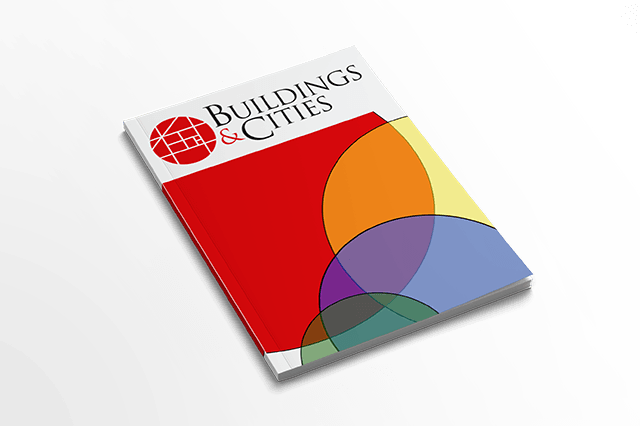
www.buildingsandcities.org/insights/commentaries/reframing-sustainable-construction.html
Reframing Sustainable Construction

Why a new approach to sustainable development is needed.
Alice Moncaster (University of the West of England) reflects on the lack of progress in sustainable development over several decades. This failure is argued to be linked to how sustainable development has been framed: the separation of technical issues from social justice and equity. Understanding, involving and empowering communities (and wider society) is the key to making progress and achieving sustainable development goals.
Introduction: sustainable development
Over 30 years ago, sustainable development was defined as a concept which combined technical concerns, e.g. limiting resource use and protecting ecosystems, with social aspirations, in particular equity within and across nations and generations. The World Commission on Environment and Development (WCED) Brundtland report Our Common Future (1987) divided sustainable development into six wide-ranging sub-issues: population, food security, ecosystems, energy ('choices for environment and development'), industry ('producing more with less') and the urban challenge. The United Nations Conference on Environment and Development (UNCED) Agenda 21 (1992) added recommendations that local authorities should lead change, and that 'ongoing consultation and partnership with a wide range of actors in the local community' were a necessary precursor for sustainable development. These influential initiatives led to the series of Conferences of the Parties (COPs) and the Millenium Development Goals (MDGs), now revised as the Sustainable Development Goals (SDGs).
The two reports therefore offered a way of framing of the complex concept of sustainable development. Frames are 'cognitive shortcuts that people use to help make sense of complex information ...through selective simplification' (Kaufman et al. 2017), a useful approach for helping to understand a problem, and thereby to finding a solution.
Martello & Jasanoff (2004) proposed, however, that rather than problems being framed in a way that helps us to find solutions, it is often the other way round: how we have already chosen to solve the problem will determine how we then decide to frame it. Flyvbjerg (1998) demonstrated further that our chosen solutions are only accepted when they are proposed by those already in positions of power, while solutions suggested by the less powerful are more likely to be dismissed. What are understood to be valid solutions to, and appropriate framings of, a problem, then, depend more on who is providing the solutions than on what they are claiming them to be. This matters, because it means that the people who hold power will determine how a problem is framed, and therefore what solutions are proposed. Alternative perspectives and framings which might be equally, or more, valid are excluded from the debate.
In the decades following the WCED report and Agenda 21 there was an abundance of academic writing proposing different framings for sustainable development. Palmer et al. (1997) represented it as four quadrants of Environment, Equity, Public Participation and Futurity. Hopwood et al. (2005) mapped the then global initiatives on a graph of environment against equality, identifying three zones from the current 'status quo' (low on both axes) through to 'transformation' (high on both). Williams and Millington (2004) framed sustainability in terms of our approach to Earth's resources, and described concepts of 'strong sustainability' as that which reduces the demand on resources and necessarily involves social change, and 'weak sustainability' which assumes that solely technical solutions will be capable of replacing spent resources.
From sustainable development to sustainable construction
Global initiatives and policy directives make an impact through their implementation within industrial sectors, and ultimately through the individuals who have the power to act on the directives (Barrett & Fudge 1981). Moncaster and Simmons (2015) suggest that this implementation is also a political process, including contests over control of decisions, negotiation and compromise.
Policies in Europe have long focused on energy efficiency of buildings (Economidou et al. 2020), including the Energy Performance of Buildings Directive (EPBD) enacted chiefly through the mechanism of national building regulations, requiring gradual improvements to new buildings. A year after the EPBD first came into effect, Charles Kibbert guest edited a special issue of Building Research and Information on 'The next generation of sustainable construction' (Kibbert 2007); the papers in this issue suggest that just one year after the ratification of the EPBD, 'sustainable construction' was predominantly being framed as the need to reduce operational carbon. This ignores a number of other long standing technical issues, including the embodied energy and carbon cost of new buildings (Szalay 2007), while the operational energy of existing buildings has failed to achieve reductions (Filippidou et al. 2017). Shove also points out that the EPBD framing ignores the fact that energy efficiency is not the same as energy reduction (Shove, 2018). While wider perspectives continued to be discussed in the academic literature (for example Murtagh et al. 2020), Udomsap and Hallinger (2020) find that the predominant framing of sustainable construction has continued to focus on technical issues of materials, construction management, and recycling and waste reduction, with social sustainability issues much less considered in this domain.
Whoever has made this choice of framing, two recent reports from the UN (UNEP 2024; United Nations 2024) suggest that the reduction of carbon emissions from the built environment has not yet been achieved. This raises the question: might alternative approaches to sustainable development and sustainable built environment focused on equity as well as the environment achieve more? This could consider the needs and views of local communities, and be led by local authorities, as recommended by Agenda 21 and the earlier academic framings discussed above.
Re-framing sustainable construction
A number of examples of such alternative framings can be found, both led by industry and academia. One has recently been offered by the Royal Institute of British Architects (RIBA, 2024) which commissioned sixteen expert 'horizon scans' to identify what should be done differently over the next ten years, identifying anew the need to understand both global differences and appropriate local responses. One scan for example suggested that for Europe, with a mature building stockand population growth predicted to be almost static up to 2050, political change is needed to move towards greater equality, rather than more construction adding further carbon emissions. In Africa, however, the population is predicted to grow by one billion people over the next 25 years, with the majority using only a fraction of the energy of Europeans and sharing little historic responsibility for climate change. Across much of this continent there is a huge need for appropriate sustainable and low carbon housing and infrastructure to combat poverty and provide resilience.
The negative impacts of global trade are also important. A study of brickmaking in Bangladesh demonstrates a widespread detrimental impact in both social and environmental terms, with the removal of topsoil leading to local flooding and crop losses, and in turn, to increased social reliance on often indentured work in polluting and toxic brick kilns (Parsons et al. 2024). The local environmental degradation is further magnified by global climate change, which in turn is also directly affected by the hidden carbon impacts of these bricks being exported long distances to other countries. These local and global environmental and social costs are invisible to purchasers, and no part of this impact is considered in the current dominant framing of sustainable construction.
The potential role of local authorities is demonstrated through a local authority-led project exploring innovative approaches to increasing resilience to groundwater flooding in the UK. One aspect of Project Groundwater focuses on community resilience and has funded research by Claude Nsobya who compares case studies from Uganda with the Chilterns (UK) (Nsobya et al. 2024). The project rationale starts from the acceptance that technical solutions to mitigate flood risk are just not enough; instead, it is critical to work with and within communities to increase social, community, economic and individual human capacities for resilience, while recognising and accepting the critical role of the local authority in supporting communities.
Recombining equity and environment
The important message of the Brundtland Report and Agenda 21, and the earlier academic framings of sustainable development, focused on the twin aims of improving equity and protecting the environment at global and local scales. However those who have determined the current framing of sustainable development have addressed these separately, focusing on technical solutions to decarbonisation while often excluding the concerns of local communities and failing to empower local authorities to lead change. There is growing evidence that this framing has failed. If governments and global leaders are serious about their ambitions for sustainable development, then alternative perspectives and framings must be considered. Sustainable construction, too, needs to allow new voices, from communities, local authorities, and the widest section of society, to reframe the concept to one which recognises social justice and equity as its principal concern.
References
Barrett, S. & Fudge, C. (eds.). (1981). Policy and Action: Essays on the Implementation of Public Policy. London: Methuen.
Economidou, M., Todeschi, V., Bertoldi, P., D'Agostino, D., Zangheri, P. & Castellazzi, L. (2020). Review of 50 years of EU energy efficiency policies for buildings. Energy and Buildings, 225, 110322.
Filippidou, F., Nieboer, N. & Visscher, H. (2017). Are we moving fast enough? The energy renovation rate of the Dutch non-profit housing using the national energy labelling database. Energy Policy, 109, 488-498.
Flyvbjerg, B. (1998). Rationality and Power: Democracy in Practice. Chicago: University of Chicago Press.
Hopwood, B., Mellor, M. & O'Brien, G. (2005). Sustainable development: mapping different approaches. Sustainable development, 13(1), pp.38-52.
Kaufman, S., Elliott, M. & Shmueli, D. (2003). "Frames, Framing and Reframing." In Beyond Intractability. Eds. Guy Burgess and Heidi Burgess. Conflict Information Consortium, University of Colorado, Boulder. http://www.beyondintractability.org/essay/framing.
Kibert, C. J. (2007). The next generation of sustainable construction. Building Research & Information, 35(6), 595-601.
Martello, M. L. & Jasanoff, S. (2004). Introduction: globalization and environmental governance. In: Earthly Politics: Local and Global in Environmental Governance. Cambridge, MA: MIT Press.
Moncaster, A.M. & Simmons, P. (2015) Policies and outcomes for UK sustainable schools. (Special Issue 'Closing the Policy Gaps'). Building Research and Information, 43 (4), pp 452-464
Murtagh, N., Scott, L. & Fan, J. (2020). Sustainable and resilient construction: Current status and future challenges. Journal of Cleaner Production, 268, 122264.
Nsobya, C., Moncaster, A., Potter, K., Mabon, L. & Ramsay, J. (2024, June). A conceptual framework for understanding community resilience to flooding. In: IOP Conference Series: Earth and Environmental Science (1363(1), 012078). IOP Publishing.
Palmer, J., Cooper, I., & Van der Vorst, R. (1997). Mapping out fuzzy buzzwords‒who sits where on sustainability and sustainable development. Sustainable development, 5(2), 87-93.
Parsons, L., de Campos, R.S., Moncaster, A., Cook, I., Siddiqui, T., Abenayake, C., Jayasinghe, A.B., Mishra, P., Ly Vouch, L. & Billah, T. (2024). Globalized climate precarity: environmental degradation, disasters, and the international brick trade. Annals of the American Association of Geographers, 114(3), 520-535.
RIBA. (2024). Architecture must change beyond recognition to meet the climate challenge, says new RIBA Horizons 2034 programme. https://www.architecture.com/knowledge-and-resources/knowledge-landing-page/architecture-must-change-beyond-recognition-to-meet-the-climate-challenge-says-new-riba-horizons-203
Shove, E. (2018). What is wrong with energy efficiency? Building Research & Information, 46(7), 779-789.
Szalay, A.Z.Z. (2007). What is missing from the concept of the new European Building Directive? Building and Environment, 42(4), 1761-1769.
Udomsap, A.D. & Hallinger, P. (2020). A bibliometric review of research on sustainable construction, 1994-2018. Journal of Cleaner Production, 254, 120073.
United Nations (1992) United Nations Conference on Environment and Development (UNCED) Rio de Janiero. https://www.un.org/en/conferences/environment/rio1992
United Nations (2024). World Social Report 2024- Social Development in Times of Converging Crises: A Call for Global Action. New York: UN Department of Economic and Social Affairs. https://desapublications.un.org/publications/world-social-report-2024-0
UNEP (2024). Emissions Gap Report: No more hot air… please! Nairobi: United Nations Environment Programme. https://www.unep.org/resources/emissions-gap-report-2024
Williams, C.C. & Millington, A.C. (2004). The diverse and contested meanings of sustainable development. The Geographical Journal, 170, 99-104
World Commission on Environment and Development. (1987). Our Common Future. Oxford: Oxford University Press.
Latest Peer-Reviewed Journal Content
Built environment governance and professionalism: the end of laissez-faire (again)
S Foxell
Co-creating justice in housing energy transitions through energy living labs
D Ricci, C Leiwakabessy, S van Wieringen, P de Koning & T Konstantinou
HVAC characterisation of existing Canadian buildings for decarbonisation retrofit identification
J Adebisi & J J McArthur
Simulation and the building performance gap [editorial]
M Donn
Developing criteria for effective building-sector commitments in nationally determined contributions
P Graham, K McFarlane & M Taheri
Reimagining circularity: actions for optimising the use of existing buildings
R Lundgren, R Kyrö, S Toivonen & L Tähtinen
Effective interdisciplinary stakeholder engagement in net zero building design
S Vakeva-Baird, F Tahmasebi, JJ Williams & D Mumovic
Metrics for building component disassembly potential: a practical framework
H Järvelä, A Lehto, T Pirilä & M Kuittinen
The unfitness of dwellings: why spatial and conceptual boundaries matter
E Nisonen, D Milián Bernal & S Pelsmakers
Environmental variables and air quality: implications for planning and public health
H Itzhak-Ben-Shalom, T Saroglou, V Multanen, A Vanunu, A Karnieli, D Katoshevski, N Davidovitch & I A Meir
Exploring diverse drivers behind hybrid heating solutions
S Kilpeläinen, S Pelsmakers, R Castaño-Rosa & M-S Miettinen
Urban rooms and the expanded ecology of urban living labs
E Akbil & C Butterworth
Living with extreme heat: perceptions and experiences
L King & C Demski
A systemic decision-making model for energy retrofits
C Schünemann, M Dshemuchadse & S Scherbaum
Modelling site-specific outdoor temperature for buildings in urban environments
K Cebrat, J Narożny, M Baborska-Narożny & M Smektała
Understanding shading through home-use experience, measurement and modelling
M Baborska-Narożny, K Bandurski, & M Grudzińska
Building performance simulation for sensemaking in architectural pedagogy
M Bohm
Beyond the building: governance challenges in social housing retrofit
H Charles
Heat stress in social housing districts: tree cover–built form interaction
C Lopez-Ordoñez, E Garcia-Nevado, H Coch & M Morganti
An observational analysis of shade-related pedestrian activity
M Levenson, D Pearlmutter & O Aleksandrowicz
Learning to sail a building: a people-first approach to retrofit
B Bordass, R Pender, K Steele & A Graham
Market transformations: gas conversion as a blueprint for net zero retrofit
A Gillich
Resistance against zero-emission neighbourhood infrastructuring: key lessons from Norway
T Berker & R Woods
Megatrends and weak signals shaping future real estate
S Toivonen
A strategic niche management framework to scale deep energy retrofits
T H King & M Jemtrud
Generative AI: reconfiguring supervision and doctoral research
P Boyd & D Harding
Exploring interactions between shading and view using visual difference prediction
S Wasilewski & M Andersen
How urban green infrastructure contributes to carbon neutrality [briefing note]
R Hautamäki, L Kulmala, M Ariluoma & L Järvi
Implementing and operating net zero buildings in South Africa
R Terblanche, C May & J Steward
Quantifying inter-dwelling air exchanges during fan pressurisation tests
D Glew, F Thomas, D Miles-Shenton & J Parker
Western Asian and Northern African residential building stocks: archetype analysis
S Akin, A Eghbali, C Nwagwu & E Hertwich



Latest Commentaries
Building-Related Research: New Context, New Challenges
Raymond J. Cole (University of British Columbia) reflects on the key challenges raised in the 34 commissioned essays for Buildings & Cities 5th anniversary. Not only are key research issues identified, but the consequences of changing contexts for conducting research and tailoring its influence on society are highlighted as key areas of action.
Lessons from Disaster Recovery: Build Better Before
Mary C. Comerio (University of California, Berkeley) explains why disaster recovery must begin well before a disaster occurs. The goal is to reduce the potential for damage beforehand by making housing delivery (e.g. capabilities and the physical, technical and institutional infrastructures) both more resilient and more capable of building back after disasters.